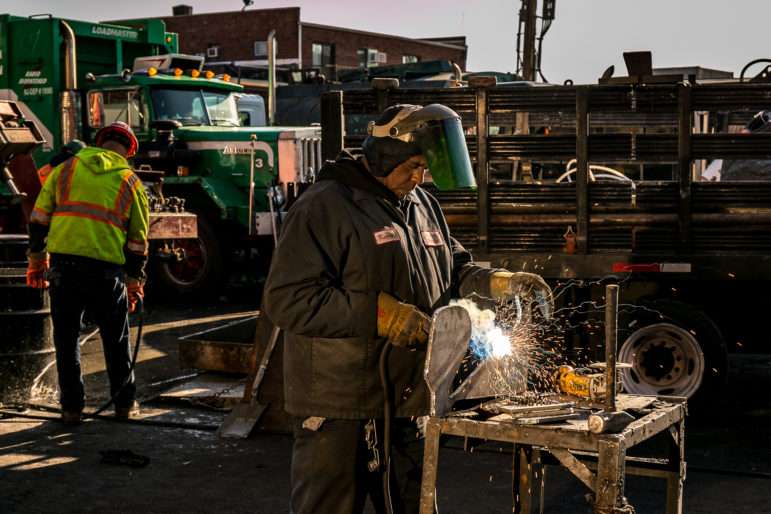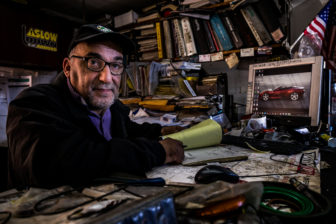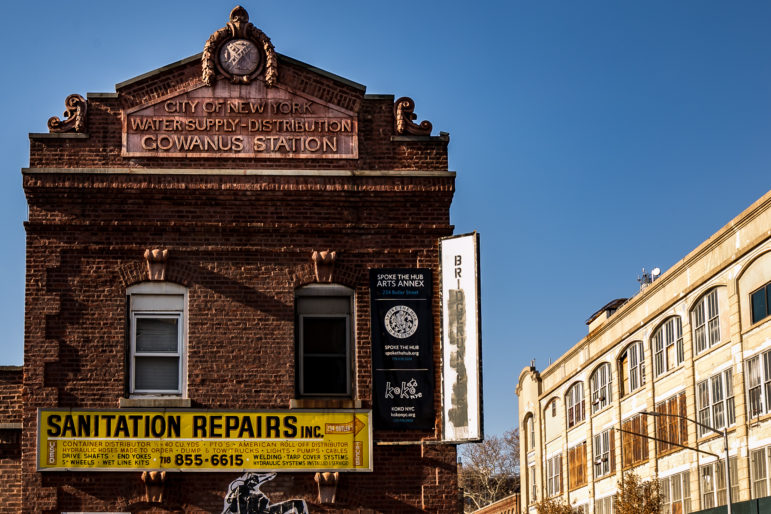
Adi Talwar
Kenneth Currie fabricating a sanitation truck hook that is used for lifting trash containers. Currie has worked for five years at Sanitation Repairs, a firm that will have to relocate to permit the clean-up of the Gowanus Canal.
The Tagliavia family has been repairing garbage trucks and sanitation equipment in Gowanus since 1973. But their business is among nearly two dozen that will be displaced with the city’s controversial plans to build a sewage overflow tank at the head of the Gowanus Canal.
“A lot of industry is disappearing from Gowanus now and this just contributes to that,” said Salvatore Tagliavia, the owner of a Butler Street parcel that houses his business — Sanitation Repairs — and three others. “We are waterfront property in Brooklyn. To see it developed is one thing but to see it made into a sewage tank is an injustice to the community.”
Department of Environmental Protection (DEP) officials have their sights set on acquiring three private parcels along the toxic canal for an 8-million gallon tank that will divert raw sewage from the waterway after its federal Superfund cleanup.
The controversial plans will repurpose coveted manufacturing land from 19 businesses at 234 Butler St., 242 Nevins St., and DEP will also commandeer 270 Nevins St. where the land will be leased as a staging area during the tank’s construction, which is expected to wrap up around 2028.
A second 4-million gallon tank will be built at a Sanitation Department facility on Second Avenue and Fifth Street at a later date.
The plans would raze structures that contribute to the neighborhood’s eligibility as a historic district under the National Register of Historic Places. This includes the more than century-old Gowanus station building on Tagliavia’s land — 234 Butler St. — whose looming destruction has spurred some skepticism from state officials and locals.
The 1.8-mile long canal was once used as a dumping ground by manufactured gas plants, paper mills, tanneries and chemical plants. Heavy pollutants were discharged into the waterway and sewage from the city’s sewer system overflows have transformed the canal into one of the nation’s most polluted bodies of water.
In 2010, the Environmental Protection Agency (EPA) designated the canal a federal Superfund site to cleanup the long-neglected waters. And once the EPA finishes dredging toxic muck from the bottom by 2027, the city-run sewage tanks will be a key step in keeping the canal clean by sucking up waste destined for the waterway.
The city’s initial plans called for the tank to be built beneath Thomas Greene Park and the “Double D” pool, which resides on contaminated land and will need to be dug up anyway to remove thick layers of coal tar. But DEP fought the EPA to build the tank elsewhere because the city did not want the neighborhood to lose access to a community resource with the years-long closure of the park and pool.
“The city has always had two priorities with the Gowanus canal cleanup: Protecting the Superfund remedy as well as the Double D Pool and Playground for the underserved communities in the area,” said Edward Timbers, a DEP spokesman.
Now, instead of building on the city-owned community space, DEP will give several businesses the boot including mechanics, a plumber, construction companies and the Eastern Effects film studio, which has used the area to film scenes for its 1980s Russian spy series “The Americans.”
Some local activists have railed against the decision.
“I think there is a moral issue here,” said Linda Marino, co-founder of the local group Friends and Residents of the Greater Gowanus at a recent Brooklyn borough president hearing on the project. “I’m not an engineer but it makes sense to me that a tank could be built on another location rather than taking someone’s private property and their livelihood.”
Critics argue that the location is far from ideal, but the two-block stretch of land along Nevins Street between Butler and Sackett streets is the most efficient option for the city, according to one DEP rep.
“The location has the most hydraulic efficiency that maximizes the capture of [sewage]. There are a lot of pluses with this site,” said Mario Bruno, the Assistant Commissioner for Intergovernmental Affairs at a recent land use hearing. “It also allows for a shorter construction period, and rather than destroy parkland, we are able to add open space above the tank and provide waterfront access.”
Several local organizations support locating the tanks under the businesses because taking the park would represent an environmental injustice.
The Economic Development Corporation is already in talks to relocate Eastern Effects to Sunset Park and plans to help the remaining businesses find new homes and help with moving costs once their land has been acquired, said Bruno.

Salvatore Tagliavia at his sanitation truck repair business, Sanitation Repairs.
The city aims to purchase the lots — or lease in the case of 270 Nevins St. — but if that fails the canal-adjacent land will be seized through eminent domain. And if the city can’t acquire the lots by 2020 — or meet any of its other timeline goals — the feds will force the city to move forward with installing the tanks under the pool and parkland, according to Christos Tsiamis, the remediation project manager for the Gowanus Canal Superfund cleanup.
That strict schedule could be complicated by the historic Gowanus station building if the city preserves the structure with its unique terracotta pediment that declares “City of New York Water Supply — Distribution Gowanus Station.” And the state is urging the city to take a “hard look at retaining and preserving” the building, according to an October letter from the State Historic Preservation Office (SHPO).
“Its demolition would adversely affect both the building and the National Register eligible Gowanus Canal Historic District,” wrote Olivia Brazee, Historic Site Restoration Coordinator with SHPO, in a letter to the EPA. “To destroy this intact, architecturally distinctive example of Brooklyn’s civic and industrial heritage would be a disservice to the Gowanus neighborhood and to the city as a whole.”
At the very least, builders plan to incorporate the pediment into the new facility’s design but maintain that preserving the building will be a costly endeavor since it will need to be “shored up” to withstand vibrations from the neighboring sewage tank construction, according to Kevin Clarke, a portfolio manager with DEP.
The project area was surveyed by the city’s Landmark Preservation Commission (LPC), which ruled that the 234 Butler Street station house was not eligible for a landmark designation, said LPC spokeswoman Zodet Negron. But the city is still reviewing the possibility of preserving all or part of structure, partially at the state’s urging.
An environmental impact statement for the project noted its potential effect on the area’s historic and cultural resources, but the loss of 19 businesses to the local economy did not raise red flags, explained another DEP expert.
“We didn’t identify any socioeconomic impacts because the businesses that are there are of a nature that could be expected to relocate to available sites nearby and they don’t provide — collectively — services that are essential to the local economy,” said Terrell Estesen, the director of wastewater review and special projects, at a recent Community Board 6 land use meeting.
That view does little to lessen the blow for those forced out of their spaces.
“I’m glad this tank will help the canal, but what about the small guys like me? They need to think about us too,” said Sheepshead Bay resident Anton Spitsin, who sold his apartment to invest in his three-year old company, The Environmental Recycling of NY Corp, which recycles bottles and cans. “I believe in this business. It’s important for the environment, to the community who comes here to trade in their bottles. But what can I do? If I have to go, I’ll go.”
Resources for the area’s arts could also take a hit with the loss of Spoke the Hub’s Gowanus location, an arts non-profit that offers rental space for artists and performers and classes from actors workshops to Hawaiian dance to yoga sessions. The site is not a permanent location for the group but it would be a severe hardship for Spoke the Hub if it had to relocate within the next year, according to a representative with the non-profit.
It’s hard for some locals to stomach the losses when the sewage tank will only reduce the amount of raw sewage spewing into the canal during heavy storms and not eliminate it entirely.
“I think it’s pretty crazy. All this is happening and it’s still not going to be completely clean,” said Karen Gibbons, who lives and works directly across Eastern Effect’s film studio on Nevins Street. “In a perfect world the canal would be 100 percent clean without fecal matter.”
As part of the Superfund cleanup, the EPA will dredge the canal’s infamous “black mayonnaise” — a 10-foot layer of toxic muck at the waterway’s bottom — which will be followed by a process known as capping that will lay two feet of sand, clay and other granular materials to prevent contaminants from migrating up into the water.
After the Feds $506 million cleanup, the tank at the head of the canal and the smaller one off of Second Avenue, which will cost an estimated $825 million, will sop up 119 million gallons of sewage annually. This will reduce the flow of waste from approximately 130 million gallons per year to only 11 million — a more than 91 percent reduction, according to Walter Mugdan, the Superfund division director for the local EPA region.
But still leaves more than 16 Olympic-sized swimming pools’ worth of sewage streaming into the canal each year. The projected costs could continue to rise if the city moves to preserve the Gowanus station building or if the project hits any unexpected bumps along the way.

Adi Talwar
The state is urging the city to take a 'hard look at retaining and preserving' the building, according to an October letter from the State Historic Preservation Office (SHPO).
Clarification: Changes were possible at 234 Butler Street, where Tagliavia’s company is located, before it became part of the site for the sewage tank. Tagliavia had plans to lease his land to a development company for a commercial project that could have included green space, which would have forced his industrial business to relocate (and resulted in the loss of its possible historic merit.) However, those plans, which he says were initiated by the developer, did not come to fruition because of the city’s interest in the land. Now Tagliavia is focused on maintaining the lot. Complicating any project on the parcel is the fact that the land under Tagliavia’s facility is also contaminated by pollution from the same long-vanished Manufactured Gas Plant that contributed to the poisoning of the canal and the contamination under the “Double D” pool. The land will require remediation before the tank facility can be built.









12 thoughts on “Gowanus Sewage Cleanup Will Clear Out Several Businesses”
Hopefully, this will work. All too often sewage removal and sewage cleanup is necessitated by man’s decisions. To put something together that seems to be the right thing to do at the time, could be ok, for the moment. But as time elapses we sometimes realize after its all too late that maybe we should have done it another way. Especially when dealing with the environment involving a sewer leak or sewage backup, do we really need to be careful.
Are there any measures to reduce the amount of waste going into the canal? What are the sources? Industrial? Household waste? Can we increase awareness or digest that waste; another way besides just dumping it?
Why didn’t you interview anyone connected with or use Thomas Greene Park? This story does not tell the whole story. I am president of the Friends of Thomas Greene Park. We are a not for profit advocacy group who has been working with local politicians and the Parks Department to improve this park for ten years. It now has kids and parents from Gowanus, Boerum Hill, Park Slope and Carroll Gardens who use this only green space in Gowanus as a destination for swimming, using a refurbished playground and picnicking. Thank you, Sue Wolfe
Unfortunately, this article leaves out a number of important points. The businesses mentioned are on land that is contaminated and needs to be cleaned, regardless of tank siting. The owner of the property that has the historic wall will probably sell his land to developers after the Gowanus rezoning, and the businesses will be displaced anyway. It is misleading to blame the sewage tanks for something that is inevitable due to both of these factors.
Most importantly, the article leaves out the fact that, if the sewage tanks are built instead, on the local playground and pool site, that one third of the public use land there will be lost forever to the community and it’s children, many of whom live in public housing.
This will likely trigger an environmental justice lawsuit which could delay any sewage tank building.
While it is easy to relocate a few businesses that are going to be displaced anyway, the lost park land is harder to replace.
The city is right to protect the rights and needs of it’s most vulnerable residents – the local kids from public housing.
The article quotes “local activists” from one side only, which is unfortunate. It also fails to mention that the activists quoted, and the EPA, are trying to force the city to pivot to the destruction of a third of the park, and have been doing so for a long time. Taking a sudden interest in local businesses is just one in a long line of sad tactics used by these people who care little about public housing children, and who have shown this again and again over their years-long effort to deprive them of their park and playground. Quoting them out of context this way is more than a little misleading.
This is a battle over a playground and pool used by local children who do not have enough outdoor space. There is a property owner who wants to cash in on his land when the rezoning happens. There are businesses which will be forced out in the rezoning, or slightly earlier by the sewage tank. There’s a historic wall whose owner doesn’t want it landmarked because it will reduce his land’s sell-out value to developers if he can hang on to it through the rezoning.
But local activists, and EPA officials who care about local businesses? Not so much. Just the usual suspects using to press to force the city’s hand to put the sewage tank where they have always wanted it.
Wait and see if these same people use THIS ARTICLE as a tool in their effort to delay city’s efforts to acquire the land for sewage tanks – and by doing so, try to force the city to destroy one third of the Thomas Greene Playground and Double D pool. I predict it will be used as a dagger in the backs of the kids who need their space to play by the very same local activists mentioned in this article.
So instead of temporarily using a park, which could be restored after construction, comrade deBlasio’s DEP wants to confiscate private property. This is more about making the area more attractive to developers than anything else, and more pleasant for deBlasio’s many supporters in the area.
The park could not be restored.
The park is currently a toxic waste hold –simular to Live Canal site where hiuses were built over chemical dumping grounds.
Why, oh why does anyone want to kerp it as is?
I enjoyed reading this article, I felt it gave voice to those on the other end of the spectrum who will be impacted. Wether the city moves forward with this option or winds up building on the much needed park land for the area, I think it’s worth examining how these plans will likely effect those on this land. This is happening now, and I’m glad to learn that the city will offer some help in relocating the businesses that operate there now.
Pingback: Gowanus Canal superfund cleanup might derail historic district designation – PearNews
Good to see that they are finally doing something to clean up the waters. Hopefully it does not burden the moved companies too much and everyone can be happy.
Great to see them clean up the sewage. It should really improve the area in the long run. Any update on the project?
Wow this article was so insightful!
Mold remediation Chicago
mold keyword